Overview
This article delves into the critical distinctions between loose skin and belly fat, elucidating their respective causes, health implications, and management strategies.
It is essential to recognize that:
- Loose skin typically arises from aging and significant weight loss.
- Belly fat is predominantly influenced by lifestyle choices and genetic factors.
This understanding necessitates tailored approaches for effective treatment and overall well-being.
Introduction
In a world where body image and health are increasingly intertwined, understanding the complexities of loose skin and belly fat is essential for anyone navigating weight loss journeys or seeking to improve their overall well-being.
Loose skin, often a byproduct of significant weight loss or aging, presents unique challenges that differ markedly from the accumulation of belly fat, which can pose serious health risks.
As individuals strive for a healthier lifestyle, recognizing the distinctions between these two conditions and their implications is crucial for developing effective management strategies.
This article delves into the causes, health implications, and potential solutions for both loose skin and belly fat, offering insights that empower individuals to enhance their body image while prioritizing their health.
Understanding Loose Skin and Belly Fat: Definitions and Differences
Loose tissue is characterized by a loss of elasticity and firmness, often resulting from significant weight loss, aging, or pregnancy. This condition manifests as loose tissue that may hang over the underlying structures, forming an appearance that can influence self-image. In contrast, belly fat refers to the accumulation of fat around the abdomen, which can be classified as either subcutaneous fat, located just beneath the surface, or visceral fat, which encircles internal organs.
Understanding the distinctions between loose skin and belly fat is crucial, as they necessitate different management and treatment strategies.
When discussing loose skin versus belly fat, loose tissue can typically be pinched and pulled away from the form, indicating a lack of underlying support. Conversely, belly fat appears as a thicker, more substantial layer that is more challenging to manipulate. This differentiation is essential for individuals aiming to effectively address their body image and health concerns.
Statistics reveal that the prevalence of loose tissue is notably high among individuals who have undergone significant weight loss. For instance, a study on elastic fiber assessment in a massive weight loss group highlighted a complete loss of normal elastic fiber structure in the papillary dermis, indicating potential long-term effects on the integrity of the surface. Additionally, collagen fiber thickness in the reticular dermis of the morbid obesity group was measured at 9.03 ± 1.52 μm, further underscoring the impact of weight loss on skin condition.
Expert opinions illuminate the complexities of managing these conditions. Paris Sabo MD, a fellowship-trained cosmetic surgeon, emphasizes that "lifestyle changes incorporating a balanced diet, regular exercise, and stress management also play pivotal roles in managing both conditions effectively." This holistic approach is vital for achieving optimal results and improving overall body image.
Moreover, the World Health Organization has established varying cut-off points for waist-to-hip ratio (WHR) based on ethnicity, indicating differing health risks associated with belly fat. Recognizing these differences is essential for developing effective treatment plans.
In summary, recognizing the differences between loose skin and belly fat is essential for developing effective treatment plans. By tailoring strategies to address each condition, individuals can enhance their body image and overall well-being.
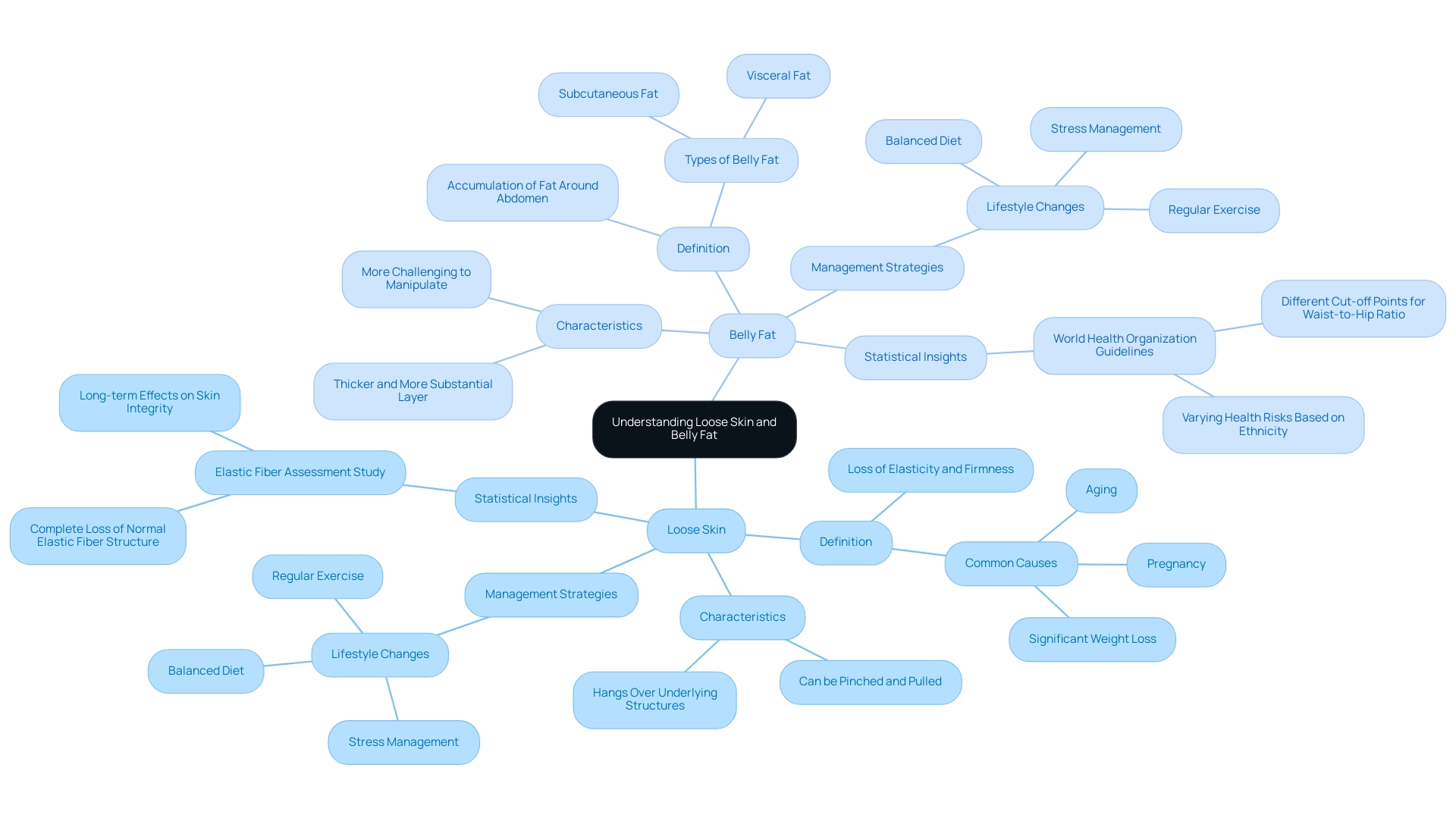
Causes of Loose Skin and Belly Fat: What You Need to Know
The comparison of loose skin versus belly fat arises from several interrelated factors, including aging, rapid weight loss, and hormonal fluctuations. As individuals age, the body's production of collagen and elastin diminishes, leading to a significant reduction in elasticity. This natural decline is compounded by rapid weight loss, especially after bariatric surgery, which can leave behind excess tissue that the body struggles to adapt to in a short timeframe.
Conversely, the accumulation of belly fat is often linked to lifestyle choices and genetic predispositions. Diets high in calories, particularly those laden with sugars and unhealthy fats, play a pivotal role in the development of abdominal obesity. Furthermore, a sedentary lifestyle and hormonal shifts can exacerbate this condition, making it crucial to understand these underlying factors to develop effective strategies for addressing both loose skin and belly fat.
Research indicates that the impact of aging on elasticity is profound, with studies showing that this organ loses approximately 1% of its collagen each year after the age of 20. Rapid weight loss can also lead to a significant decrease in elasticity, as the skin may not have sufficient time to adjust to the new body shape. This is particularly evident in individuals who experience drastic weight changes in a short period, underscoring the importance of gradual weight loss strategies.
Moreover, Vitamin C deficiency is linked to poor bodily functions, including impaired wound healing and connective tissue integrity, which can further contribute to loose skin. A significant association has also been reported between alcohol consumption exceeding 40 grams per day and wrinkling, with a relative risk of 1.35, indicating that lifestyle choices can significantly impact dermal health.
Statistics reveal that hormonal changes, particularly in women during menopause, can lead to increased belly fat, which is an important consideration in the discussion of loose skin versus belly fat due to shifts in estrogen levels affecting fat distribution in the body. Understanding these factors is essential for creating focused interventions that can effectively address both loose skin and belly fat, ultimately encouraging a healthier and more confident appearance. As noted by Qi Yi Ambrose Wong, "the literature review gathered and examined the data, emphasizing the significance of these factors in dermal well-being."
Integrating these insights enhances the effectiveness of wellness programs aimed at improving overall employee well-being.
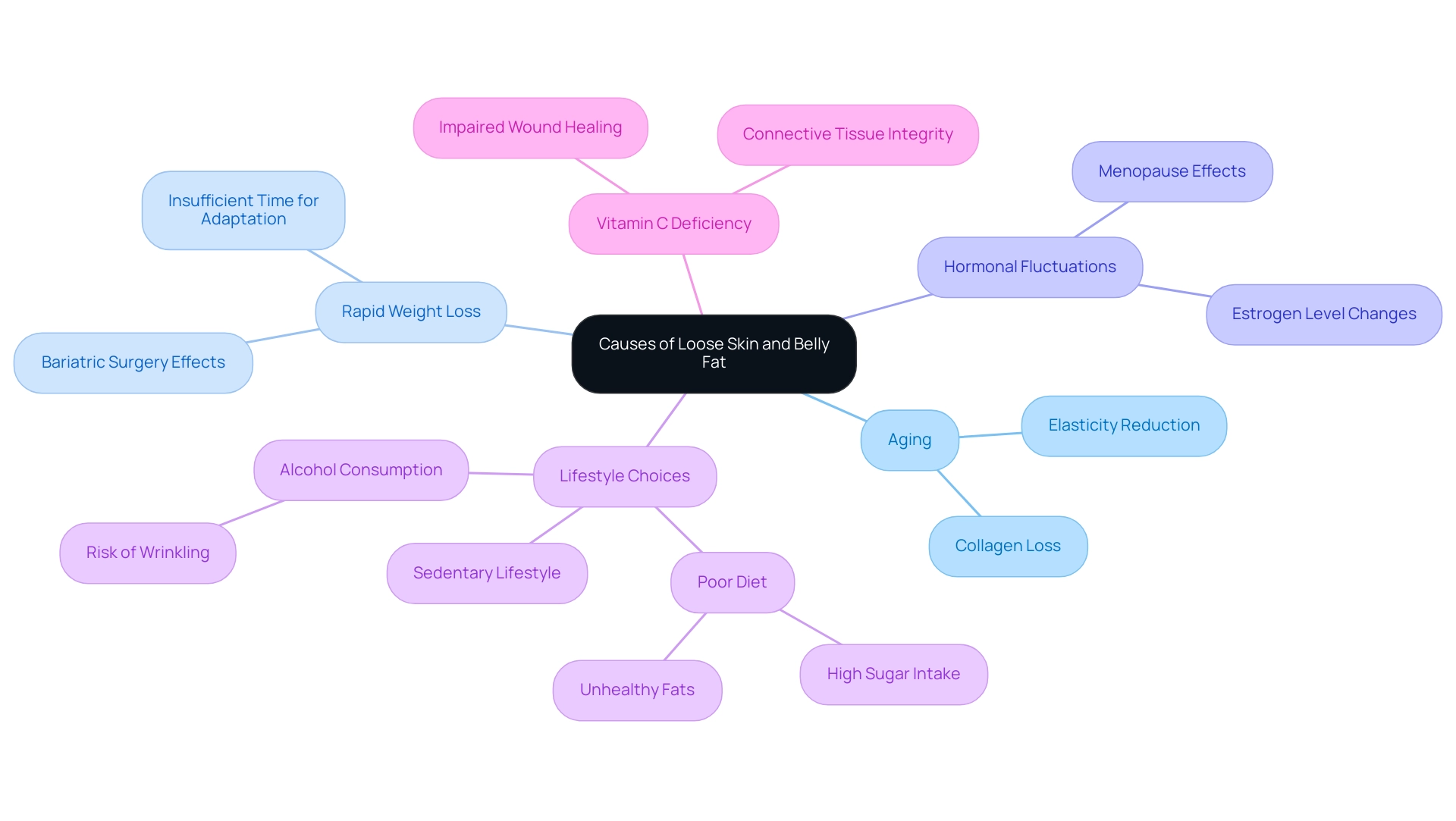
Health Implications: Why Loose Skin and Belly Fat Matter
The comparison of loose skin versus belly fat reveals a spectrum of health complications, including irritation, infections, and discomfort, especially in areas where folds develop. These issues can impede mobility and contribute to psychological distress related to body image concerns. Research indicates that after losing 100 pounds, skin may lack the elasticity to revert to its original shape, potentially exacerbating these complications.
Conversely, when examining loose skin against belly fat, particularly visceral fat presents serious risks to well-being. Studies demonstrate that visceral fat is linked to an increased risk of heart disease, diabetes, and metabolic syndrome. This type of fat is associated with inflammation and hormonal imbalances, which can aggravate existing medical issues.
Addressing the issue of loose skin versus belly fat is crucial not only for cosmetic reasons but also for maintaining overall well-being and preventing long-term illnesses. Individuals with excess belly fat are more likely to face negative outcomes, including higher rates of cardiovascular disease and type 2 diabetes. Additionally, the psychological effects of loose skin can lead to diminished self-esteem and heightened anxiety, underscoring the importance of a holistic approach to wellness that encompasses both physical and mental health.
Incorporating personalized coaching into wellness strategies can significantly enhance the journey toward addressing these challenges. Experienced coaches offer tailored support and guidance, empowering individuals to implement lasting lifestyle changes that bolster their well-being. For instance, clients have reported increased confidence and motivation after engaging with our coaching services, illustrating the positive impact of personalized support.
This individualized approach not only addresses the physical dimensions of wellness but also cultivates a positive mindset, enabling individuals to take charge of their health and well-being.
A notable case study involving adolescents post-bariatric surgery revealed that 90.3% of participants had an abdominal pannus at the time of surgery, with a significant reduction in pannus severity observed within the first 24 months. This underscores the importance of addressing surplus tissue after substantial weight loss, as it can lead to both physical discomfort and emotional challenges. As Thomas Inge, a consultant for Standard Bariatrics, notes, "The authors have nothing to disclose except for Thomas Inge, who is a consultant for Standard Bariatrics," emphasizing the necessity for professional insights in understanding these implications.
Ultimately, comprehending the effects of loose skin versus belly fat is vital for developing effective strategies to enhance overall wellness and quality of life. Integrating these considerations into corporate wellness programs, such as those offered by Corporate Membership - Contact Our Health Coaches Today, can promote a healthier, more cohesive team culture, benefiting both employees and organizations. Our evidence-based techniques, including nutritional guidance and exercise plans, are designed to support individuals in effectively achieving their health goals.
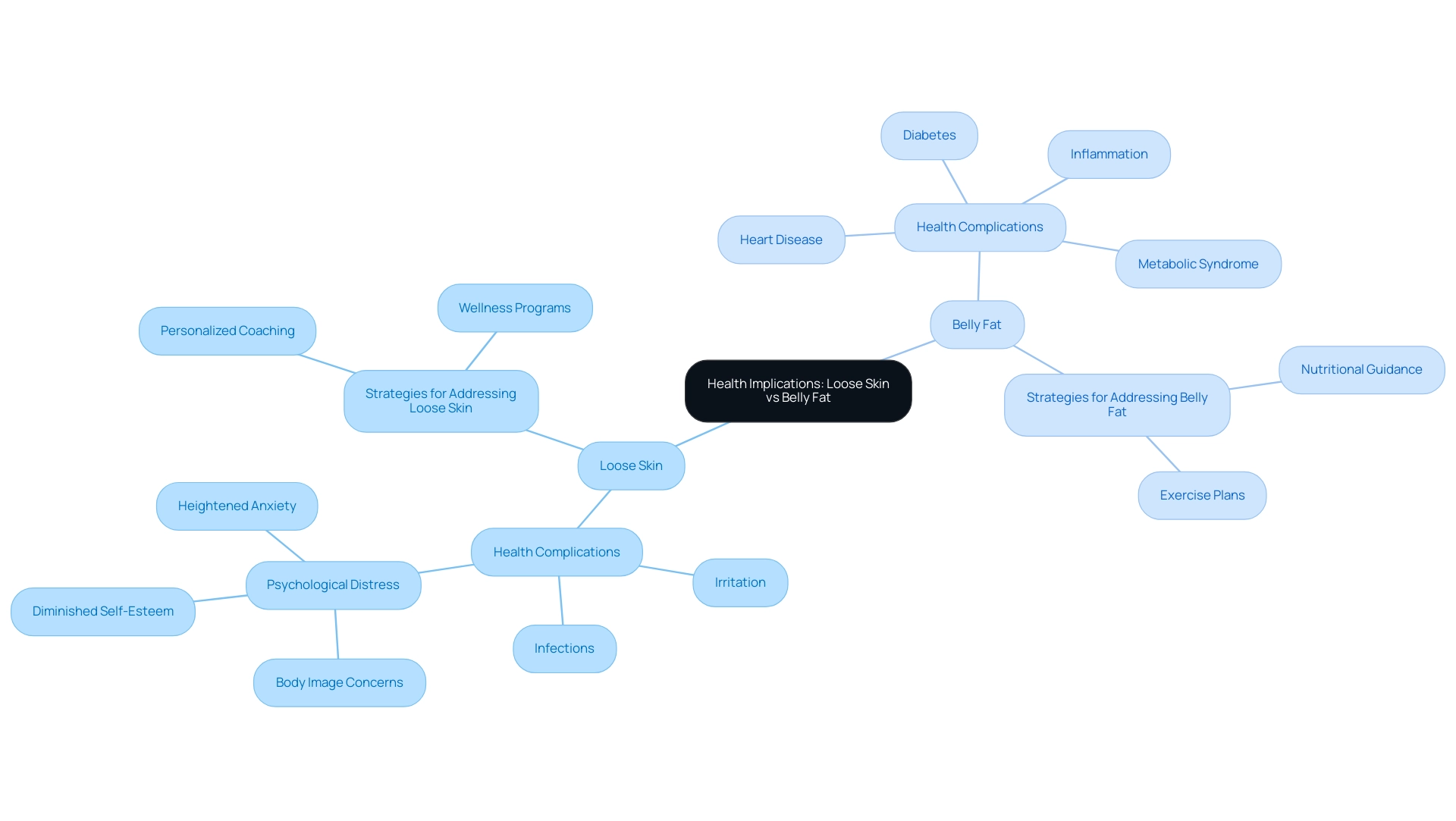
Solutions for Loose Skin: Surgical and Non-Surgical Options
For individuals seeking to tighten loose tissue, understanding the distinctions between loose skin and belly fat is essential. A variety of effective options are available. Surgical procedures, including tummy tucks (abdominoplasty) and lifts, are well-established techniques for eliminating surplus tissue and enhancing body contours. These surgeries not only improve aesthetic appearance but also contribute to increased strength and functionality.
Many patients report significant improvements in their quality of life post-surgery. Notably, a considerable number return to work within two weeks, although full recovery may take several months. However, it is crucial to recognize that only 5–7% of post-bariatric surgery patients actually undergo body contouring, despite a majority expressing interest. This disparity often arises from financial constraints and a lack of awareness.
On the non-surgical front, treatments such as laser therapy, radiofrequency treatments, and ultrasound therapy have gained popularity. These methods stimulate collagen production, which is vital for enhancing skin elasticity. Research indicates that non-surgical treatments for tightening can yield positive results, with effectiveness varying based on individual types and conditions.
For instance, studies show that patients who engage in regular exercise and maintain a balanced diet often experience improved skin complexion and elasticity over time. Incorporating resistance training into one’s fitness routine can also be advantageous, as building muscle may help fill out loose areas, providing a more toned appearance.
Dr. Francisco Bucio, a board-certified plastic surgeon, emphasizes that while surgical options offer immediate results, non-surgical treatments can serve as a complementary approach. This allows individuals to achieve gradual improvements in skin tightness. Ultimately, the choice between surgical and non-surgical options should be guided by personal goals, expert advice, and an understanding of the potential outcomes.
The case study titled "Solutions for Excess Skin after Weight-Loss Surgery" illustrates the comparison of loose skin versus belly fat. It highlights that patients opting for surgical solutions can achieve significant improvements in both strength and cosmetic appearance, with many returning to work within two weeks after the procedure, although full recovery may take months.
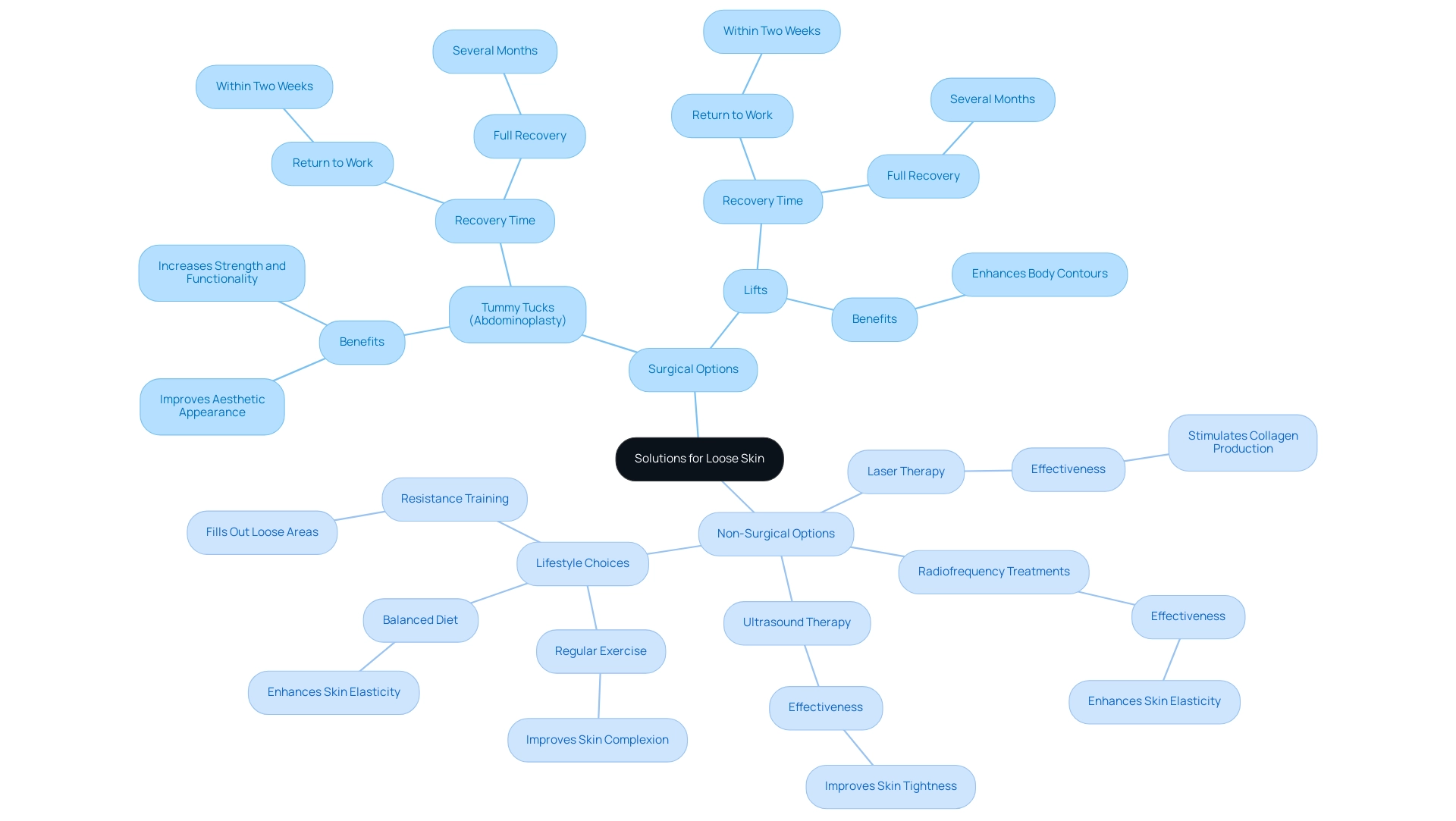
Effective Strategies for Reducing Belly Fat: Lifestyle Changes and Interventions
To effectively reduce belly fat, individuals should adopt a multifaceted approach that combines dietary modifications with regular physical activity. This strategy can be significantly enhanced through tailored corporate wellness programs offered by Corporate Membership. A diet abundant in whole foods—such as fruits, vegetables, lean proteins, and whole grains—plays a crucial role in managing weight and curbing fat accumulation. Research indicates that individuals who incorporate these dietary changes can experience significant reductions in fat, particularly in the abdominal area.
Regular aerobic exercise, including activities like walking, running, or cycling, is vital for burning calories and promoting fat loss. Studies have shown that aerobic exercise can lead to a notable decrease in belly fat, with participants often reporting improved body composition and increased aerobic capacity. Furthermore, regular exercise is associated with enhanced job performance, creativity, and stress management, highlighting its significance not only for physical well-being but also for workplace productivity.
Corporate Membership's wellness programs provide the necessary structure and support for employees to engage in these beneficial activities, including personalized wellness coaching and tailored fitness plans.
In addition to diet and exercise, managing stress through mindfulness practices and ensuring adequate sleep are essential components of a successful strategy when considering loose skin versus belly fat reduction. Chronic stress and insufficient sleep have been linked to increased abdominal fat, underscoring the importance of a balanced lifestyle. By addressing these factors, individuals can create a supportive environment for fat loss and overall improvement, which can be facilitated through Corporate Membership's wellness initiatives that prioritize mental and physical well-being, particularly in the context of loose skin versus belly fat.
Effective strategies for losing belly fat also involve understanding the differences between loose skin and belly fat, as well as setting realistic goals and tracking progress. Case studies have demonstrated that participants who engage in structured dietary programs, such as those focusing on education and skill-building in food selection, can achieve sustainable weight loss. For instance, a recent program showed participants achieving a mean weight loss of 6.49% over 12 months, highlighting the effectiveness of informed dietary choices.
This is particularly relevant in light of the growing obesity problem, as seen in regions like Africa, where obesity prevalence among women has reached alarming levels. In summary, a comprehensive approach that combines dietary changes, regular exercise, and lifestyle modifications is essential for reducing belly fat and enhancing overall well-being. As highlighted by John W. Erdman, the significance of dietary education and skill development cannot be overstated in attaining sustainable weight reduction, making these strategies not only advantageous for personal well-being but also for promoting a healthier workplace atmosphere through Corporate Membership's corporate wellness initiatives. Additionally, investing in employee health can lead to reduced absenteeism and lower healthcare costs, further enhancing the value of these initiatives.

The Emotional Impact: Navigating Body Image Issues Related to Loose Skin and Belly Fat
The emotional ramifications of loose skin versus belly fat can be significant, often causing individuals to grapple with feelings of shame, embarrassment, and diminished self-esteem. Excessive tissue, particularly after substantial weight reduction, frequently leads to dissatisfaction with one’s appearance and may result in social withdrawal. Research indicates that individuals with loose skin may experience heightened self-image issues, exacerbating mental health challenges.
For instance, studies have shown that a considerable percentage of individuals report negative self-perception linked to their image, particularly concerning loose skin versus belly fat, which is often stigmatized in society.
A case study titled "Predictive Factors for Post-Operative Discomfort in Bariatric Patients" underscores that pre-operative BMI and ptosis measurements are significant predictors of post-operative discomfort, suggesting that these factors should be considered in pre-operative assessments. This discomfort can further impact emotional well-being, as individuals may struggle with their image post-surgery. The psychological effect of these image concerns is profound.
Experts emphasize the necessity for individuals to seek emotional support through counseling, support groups, or wellness programs. Such resources can provide essential coping strategies and foster a sense of community among those facing similar challenges. Creating a positive self-image and fostering self-acceptance are essential elements of overall wellness and well-being.
Furthermore, engaging in supportive environments can significantly mitigate feelings of anxiety and promote resilience.
Data from the SF-36 Health Survey reveal significant enhancement in mental and physical well-being following bariatric surgery, highlighting the importance of addressing image issues. However, a notable portion of individuals struggling with image concerns related to loose skin versus belly fat do not receive adequate treatment or support. This gap underscores the importance of awareness and proactive measures in addressing these emotional challenges.
As noted by Ingela Lundin Kvalem, certain groups face greater challenges regarding self-image and mental well-being both prior to and following bariatric surgery, emphasizing the necessity for specialized assistance. Moreover, cultural perceptions can hinder men from acknowledging their eating disorder symptoms, further complicating the realm of image issues. By prioritizing mental health and encouraging open discussions about body image, individuals can embark on a journey toward improved self-esteem and emotional well-being.
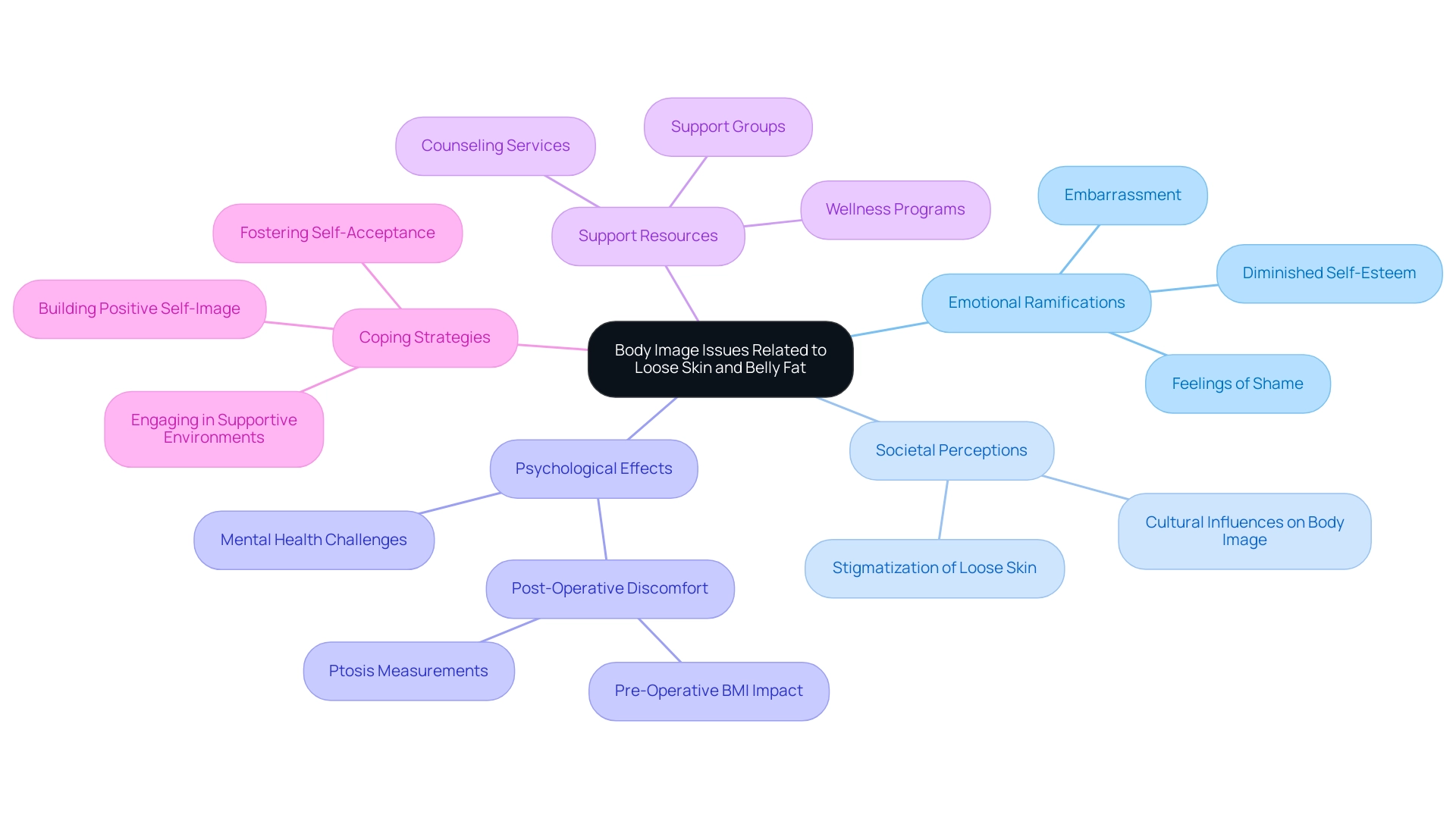
Key Takeaways: Understanding and Addressing Loose Skin vs Belly Fat
Understanding the distinctions between loose skin and belly fat is essential for effectively addressing these conditions. The comparison typically arises from factors such as aging, significant weight loss, or genetic predisposition, leading to a lack of elasticity in the skin. In contrast, the discussion is primarily influenced by dietary habits, physical activity levels, and genetic factors, contributing to an increased risk of various medical issues.
Both loose skin and belly fat have considerable consequences for well-being. Sagging tissue can lead to discomfort and dermal-related issues, while the comparison is important as both are linked to an increased risk of metabolic disorders, cardiovascular illnesses, and additional complications. Recent statistics indicate that the prevalence of obesity among adults in the United States stands at 40.3%, as noted by Brian C. Moyer, Director. This statistic emphasizes the urgency of addressing belly fat as a public issue, particularly considering the varying impacts of obesity across different racial and ethnic groups, as demonstrated in studies revealing significant differences in obesity prevalence.
Solutions for managing loose skin include both surgical options, such as skin removal procedures, and non-surgical methods like skin tightening treatments. Conversely, reducing belly fat necessitates addressing the issue of loose skin versus belly fat and requires lifestyle modifications that focus on balanced nutrition and regular exercise. Engaging in physical activity not only aids in fat reduction but also enhances overall well-being.
Moreover, it is crucial to recognize the emotional impact of these conditions. Individuals often face challenges concerning self-image, which can influence mental well-being. By adopting a comprehensive approach that includes physical, emotional, and psychological strategies, individuals can work towards improving their physical appearance and fostering a positive body image, ultimately enhancing their overall quality of life.
Foresight Health Coaching addresses the unique challenges teams face in balancing demanding workloads with healthy lifestyles. By implementing corporate wellness initiatives, organizations can assist their employees in making healthier decisions, thereby reducing the prevalence of conditions like belly fat and promoting a culture of well-being within the workplace. Our personalized coaching offers tailored support and guidance, empowering employees to thrive in the modern world while learning from the wisdom of the past.
Testimonials from our clients emphasize the effectiveness of our approach:
- "Foresight Health Coaching transformed our team's well-being and morale!"
- "The personalized coaching made a significant difference in my lifestyle choices."
Monitoring obesity prevalence is vital for understanding health trends over time and tailoring interventions that meet the specific needs of diverse populations. Take the first step towards a healthier, happier, and more cohesive team by investing in Foresight Health Coaching’s corporate partnership today.
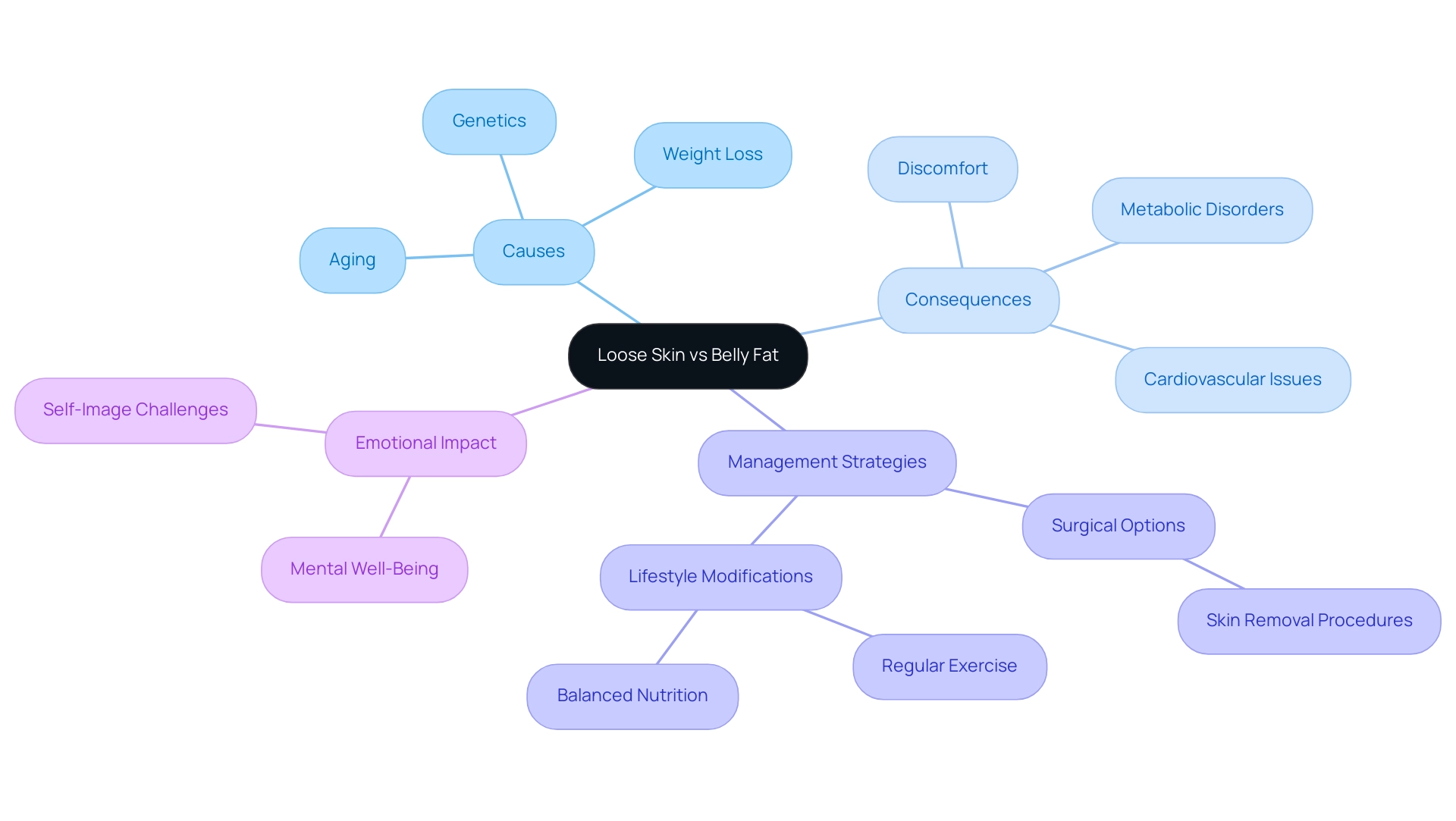
Conclusion
Understanding loose skin and belly fat reveals critical distinctions that influence both physical health and emotional well-being. Loose skin often results from significant weight loss, aging, or hormonal changes, leading to discomfort and potential health complications. In contrast, belly fat, particularly visceral fat, poses serious health risks, including heart disease and diabetes, driven largely by lifestyle choices and genetic factors.
Addressing these conditions requires tailored strategies. For loose skin, options range from surgical interventions to non-invasive treatments that stimulate collagen production. Conversely, managing belly fat necessitates a multifaceted approach that includes dietary modifications and regular exercise. Both conditions also carry emotional implications, with many individuals experiencing body image issues that can affect self-esteem and mental health.
Ultimately, a holistic approach that encompasses physical, emotional, and psychological strategies is essential for improving overall well-being. By implementing corporate wellness programs and personalized health coaching, organizations can play a pivotal role in supporting individuals on their journeys toward healthier lifestyles. Investing in such initiatives not only fosters a culture of health but also empowers employees to make informed choices that enhance their quality of life.
Frequently Asked Questions
What is loose tissue and what causes it?
Loose tissue is characterized by a loss of elasticity and firmness, often resulting from significant weight loss, aging, or pregnancy. It manifests as skin that may hang over the underlying structures, impacting self-image.
How does belly fat differ from loose tissue?
Belly fat refers to the accumulation of fat around the abdomen, which can be subcutaneous (just beneath the surface) or visceral (surrounding internal organs). In contrast, loose tissue can be pinched and pulled away from the body, indicating a lack of underlying support.
Why is it important to distinguish between loose skin and belly fat?
Understanding the differences between loose skin and belly fat is crucial because they require different management and treatment strategies. This differentiation helps individuals effectively address their body image and health concerns.
What statistics highlight the prevalence of loose tissue?
Statistics indicate that loose tissue is notably high among individuals who have undergone significant weight loss. For example, studies show a complete loss of normal elastic fiber structure in the skin of individuals who have lost a substantial amount of weight.
What role do lifestyle changes play in managing loose skin and belly fat?
Lifestyle changes, including a balanced diet, regular exercise, and stress management, are essential for effectively managing both loose skin and belly fat, as emphasized by cosmetic surgery experts.
How does aging affect skin elasticity?
Aging leads to a reduction in the body's production of collagen and elastin, resulting in a significant decrease in skin elasticity. Research indicates that the skin loses approximately 1% of its collagen each year after the age of 20.
What factors contribute to the accumulation of belly fat?
The accumulation of belly fat is often linked to lifestyle choices, such as diets high in calories, particularly those rich in sugars and unhealthy fats, as well as a sedentary lifestyle and genetic predispositions.
How does rapid weight loss impact skin elasticity?
Rapid weight loss can significantly decrease skin elasticity, as the skin may not have enough time to adjust to the new body shape, especially in individuals who experience drastic weight changes over a short period.
What lifestyle factors can affect dermal health and lead to loose skin?
Factors such as Vitamin C deficiency, excessive alcohol consumption, and hormonal changes, particularly in women during menopause, can negatively impact skin integrity and contribute to loose skin.
How can understanding these factors help in developing treatment plans?
Recognizing the differences between loose skin and belly fat, along with their underlying causes, is essential for creating focused interventions that effectively address both conditions, ultimately promoting a healthier and more confident appearance.

